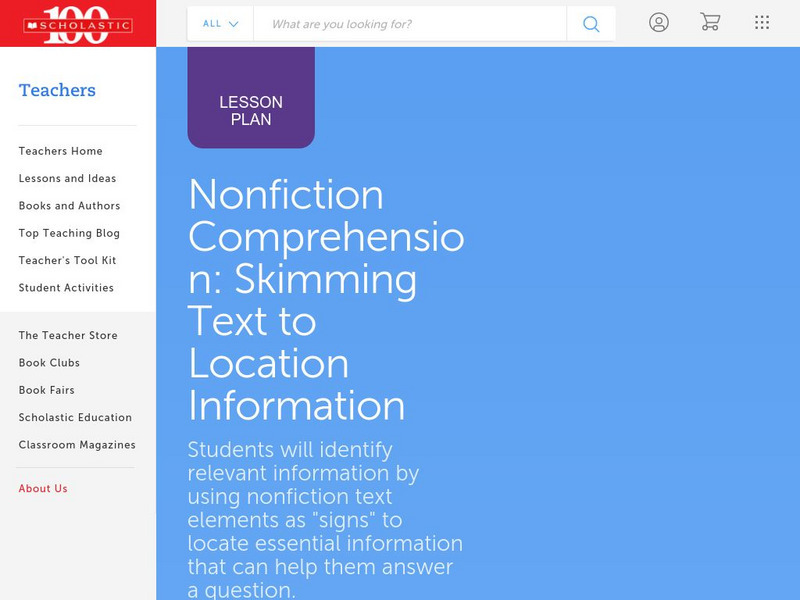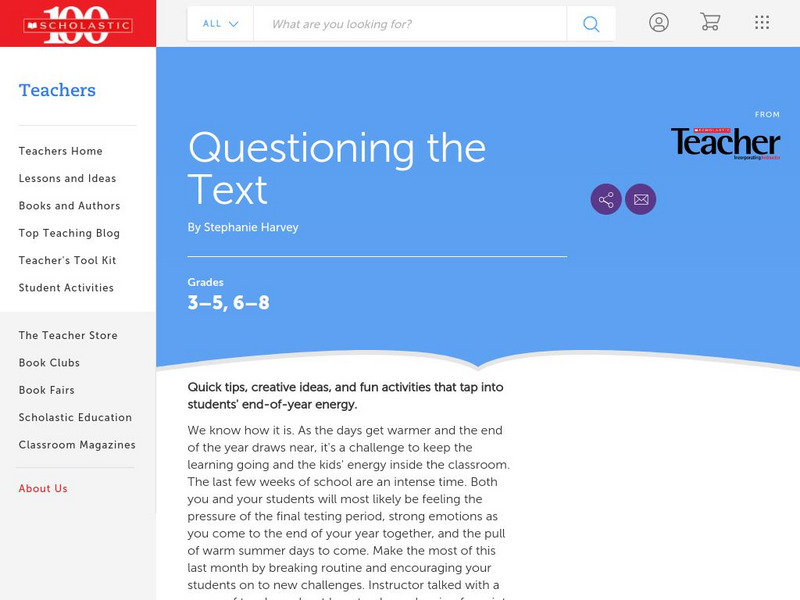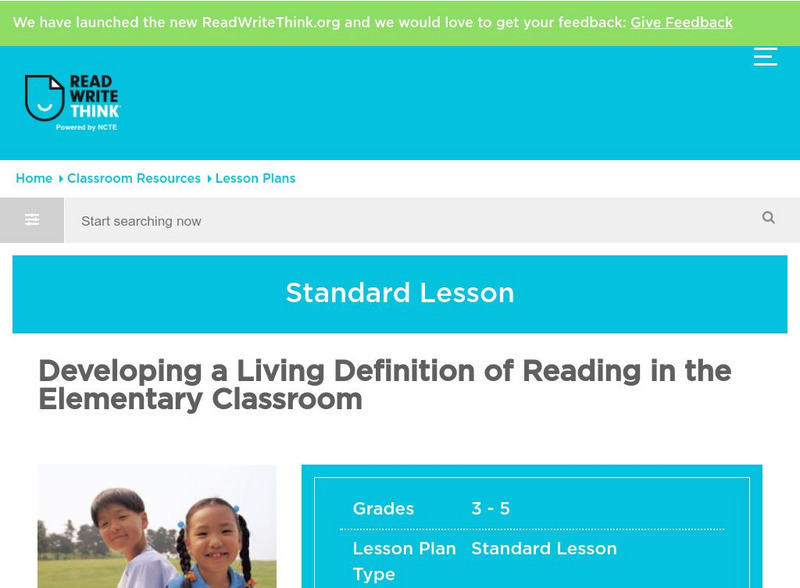Other
City College: Skills for Life: Reading for a Purpose
This resource offers 11 exercises with variety of everyday reading passages such as letters, recipes, classified ads, etc. Students read the passage and answer multiple choice questions about its purpose.
Better Lesson
Better Lesson: Text Feature Diagrams
At the end of this instructional activity, students will be able to identify and create diagrams associated with informational text. Included is a link to an eSpark video on diagrams, rules for group work, multiple examples of diagrams,...
Better Lesson
Better Lesson: Visual Representations in Informational Text
Students will look at examples of illustrations and diagrams in informational texts and discuss how each one helps enhance the text. Students gain the knowledge that sometimes a picture is worth a thousand words because a complex idea...
Better Lesson
Better Lesson: The Power of Questions
Learners will have the opportunity to work collaboratively by using the Think-Pair-Share technique to ask questions about a story. Included are examples of student's questions, and a Think-Pair-Share poster and document.
Reading Rockets
Reading Rockets: Reading Basics: Comprehension
Provides articles, parent tips, research briefs, and a video on how to teach reading comprehension.
Reading Rockets
Reading Rockets: Teaching Reading: Classroom Strategies
A collection of effective, research-based classroom strategies to help build and strengthen literacy skills in print awareness, phonological awareness, phonics, fluency, vocabulary, comprehension, and writing.
Reading Rockets
Reading Rockets: Using Collaborative Strategic Reading
In this article, the Collaborative Strategic Reading (CSR) technique is explained, along with research to support the use. The technique teaches students to use comprehension strategies, while working cooperatively, as they engage in the...
Reading Rockets
Reading Rockets: Building Background Knowledge
The importance of background knowledge is especially salient in the age of Common Core. This article offers practical classroom strategies to build background knowledge such as using contrasts and comparisons and encouraging...
Quia
Quia: Reading Comprehension (Reading for Facts)
There are 30 questions in this activity. Practice your reading skills with one or two short stories at a time. Read the story, then choose the answer that best answers the question.
Michigan State University
Michigan State University: Interventions for Reading: Reconciled Reading
This intervention, which is based on Schema Theory, engages young scholars in enrichment activities prior to reading the passage. In this way, students have the opportunity to activate and enhance existing knowledge before reading....
Michigan State University
Michigan State University: Intervention for Reading: Summarization Strategy
Improve understanding of expository materials by summarizing the main ideas. The summarization strategy helps young scholars recall the main ideas and specific facts of materials they read. There are five rules for writing summaries.
Scholastic
Scholastic: Lesson Plan for Nonfiction Comprehension: Skimming Text
Build comprehension by developing reading strategies for use with nonfiction text. This lesson focuses on teaching students to recognize text elements as clues to help them quickly locate key information in text.
Scholastic
Scholastic: Questioning the Text
In this magazine article originally featured in Instructor, the reading strategy called "questioning the text" is explained by the renowned literacy consultant and staff developer, Stephanie Harvey. The steps included for questioning the...
Beacon Learning Center
Beacon Learning Center: Web Lesson: Did I Read It: Implicit vs Explicit Details
Follow Carson through a lesson in order to become a better reader of informational text. Learn the difference between implicit and explicit information. Includes multiple interactive assessments and reading activities.
English for Everyone
Reading Comprehension Assessment: "Materials" [Pdf]
Read Theory provides a free reading comprehension assessment that is designed for reading students in intermediate elementary grades. Six multiple choice questions and two extended response questions are included on the assessment.
Curated OER
Mc Graw Hill: Part 2 Reading: Informational Text: Connections Within Text
Learn how information in a text can be connected through compare and contrast, cause and effect, and sequence.
Curated OER
Mc Graw Hill: Part 1: Reading Literature: Show Understanding of Text
This quick lesson from the Common Core Literacy eHandbook teaches students what questions to ask and how to answer questions to show your understanding of literature.
Curated OER
Mc Graw Hill: Part 2 Reading: Informational Text: Cause and Effect Text Structure
Cause and Effect is a text organization structure and knowing this structure can help you in comprehending a text. Learn about these strategies on this site.
Curated OER
Mc Graw Hill: Part 2 Reading: Informational Text: Show Understanding of Text
This quick activity includes a passage from an information text, and explains reading comprehension strategies to use to answer questions.
Other
Reading Educator: Question Answer Relationships
Based on the presumption that every teacher shares responsibility for teaching reading, this page offers a brief look at question-answer relationships, as well as suggestions for putting the strategy to use in the classroom.
Other
Eduscapes: Themes & Literature Circles
This site provides guidance in creating literature circles based on cross-curricular themes that will help to improve literacy. The site emphasizes both theory and practice, with lots of practical suggestions.
Other
Kid Bibs: Effective Use of Textbook Features
Here, parents and teachers can find tips for helping young readers understand the expository writing found in textbooks.
ReadWriteThink
Read Write Think: K W L S Chart
A printable K-W-L-S sheet to help students activate prior knowledge, ask questions, record new learning, and then ask additional questions to extend inquiry beyond the text . Directions on how to use this type of graphic organize as well...
ReadWriteThink
Read Write Think: Developing a Living Definition of Reading in the Elementary
Using the guiding question, "What is reading?" students interact with a variety of texts as they uncover the skills necessary to interact with texts and develop a definition of reading.
















